Authors: Tanaya Bhowal, Rittu Anilkumar
Only a few things are as quintessentially artistic as a wood fire baked puff. The flaky, golden crust and the aromatic richness of these puffs showcase a level of craftsmanship and taste, that beats any machine produced alternatives, without a hitch. In the heart of Singareni Colony, we had found one such hidden gem, that painted the air of the neighbourhood with the irresistible aroma of their freshly baked puffs. They were known for their mouth-watering puffs, a snack savoured by the children and adults alike in the colony.
For the past seventeen years, this bakery which is commonly referred to as ‘lakdi-ki-bhatti’, has been a testament to the hard work and friendship between two friends. However, this bakery has ceased to operate currently and has been displaced. This not only marks an end to the traditional bakeries in Singareni, but also adds to the extinction of the manual craftsmanship in a world that now thrives on automation and technology. In this blog, we unfold the tale of ‘disappearing bakeries’, as we shed light on technological transitions, their impact on economies and social relations that are so intricately tied to the urban fabric.
Singareni Colony is a hub to a large informal workforce. Every corner of this neighborhood embedded in precarity, and inadequacy is a witness to a range of livelihoods spanning from the ginger and garlic peeling and bangle-making to scrap-segregation. As we sought out to explore the thermal experience of the residents in this off-grid locality, we chanced upon the ‘lakdi-ki-bhatti’. The dim-lit bakery, within which a middle-aged worker sat in front of the oven, drenched in sweat caught our attention. It was one of those moments as a researcher where a single place could satisfy both our appetite for knowledge and our culinary curiosity.
A Bakery in the Alley
The bakery is a seventeen-year-old structure, built using exposed cement brick walls, an asbestos roof and cement flooring. Protruding from the roof, the chimney adds to its distinct appearance. At the first glance, the bakery projects as a space displaying lack of proper upkeep, haphazard arrangement of structures and materials cobbled together.
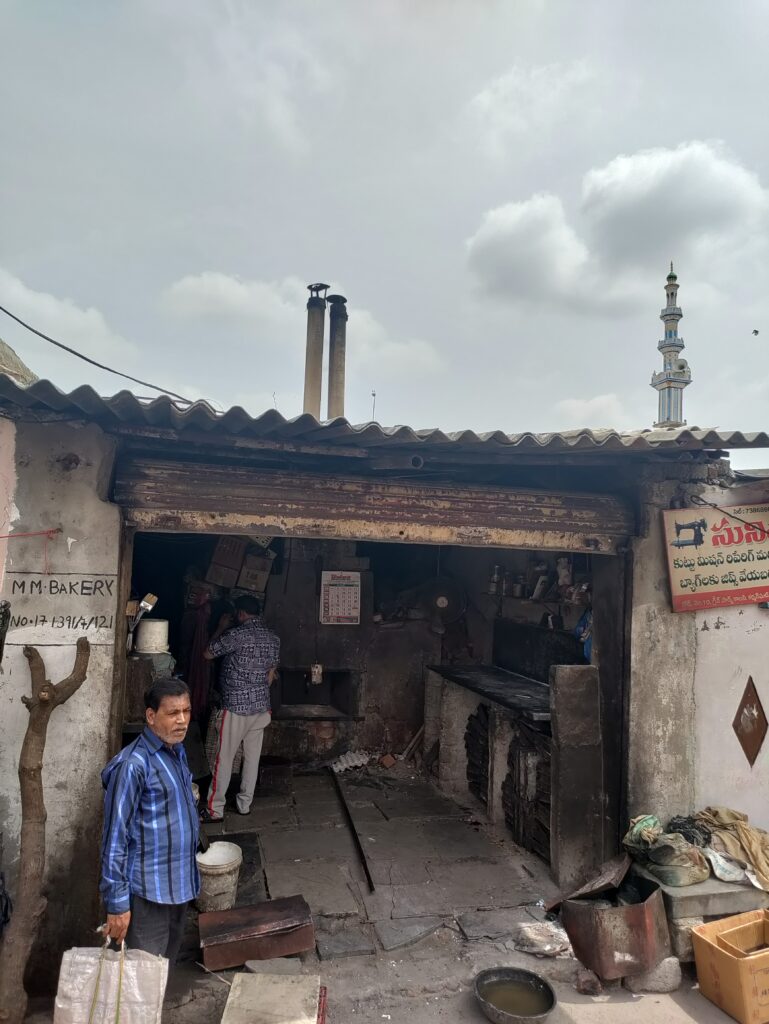
This image captures the frontal view of the bakery.
Spread over a single room, the bakery has been divided into two sections. The back section of the bakery is designated for storing wooden logs, and materials such as broken pieces of aluminium, tin, stones, waste papers etc. Meanwhile, the frontal section of the bakery is the functional space where baking and related activities take place. There are various elements within this section that would capture one’s attention. Notably, the ‘oven’ ingeniously built right in the center of the room. A pedestal fan could be seen hung from the ceiling. To the right we noticed heaps of wooden logs stacked, and on the left, there were piles of paper egg trays arranged. Stone slabs on either side of the room served as a platform for kneading and rolling the dough, preparing them to be placed on iron trays for baking. Under these slabs we could notice a multitude of iron trays being chaotically stacked one above the other. Near the entrance, a ‘chulha’ built out of local clay, surrounded by cuboidal iron sheets, stands out. Additionally, an earthen pot, covered by a damp cloth, is placed on one of the corners of the stone slabs.
Toiling in Heat
Despite the entrance to the bakery being entirely exposed to the road allowing ventilation, the interior of the bakery was scorched. We realised this was largely due to the heat emanating from the oven. We knew this was one of those places we would want to enquire more about. We had the opportunity to speak to the only two workers in the bakery – Ali and Amir1. The duo currently in their early forties, are childhood friends who were taught the art of baking when they were 12 years old by a master who they referred to as ’Ustaad’. While the former lives in Moheenbagh, the latter calls Singareni Colony home.
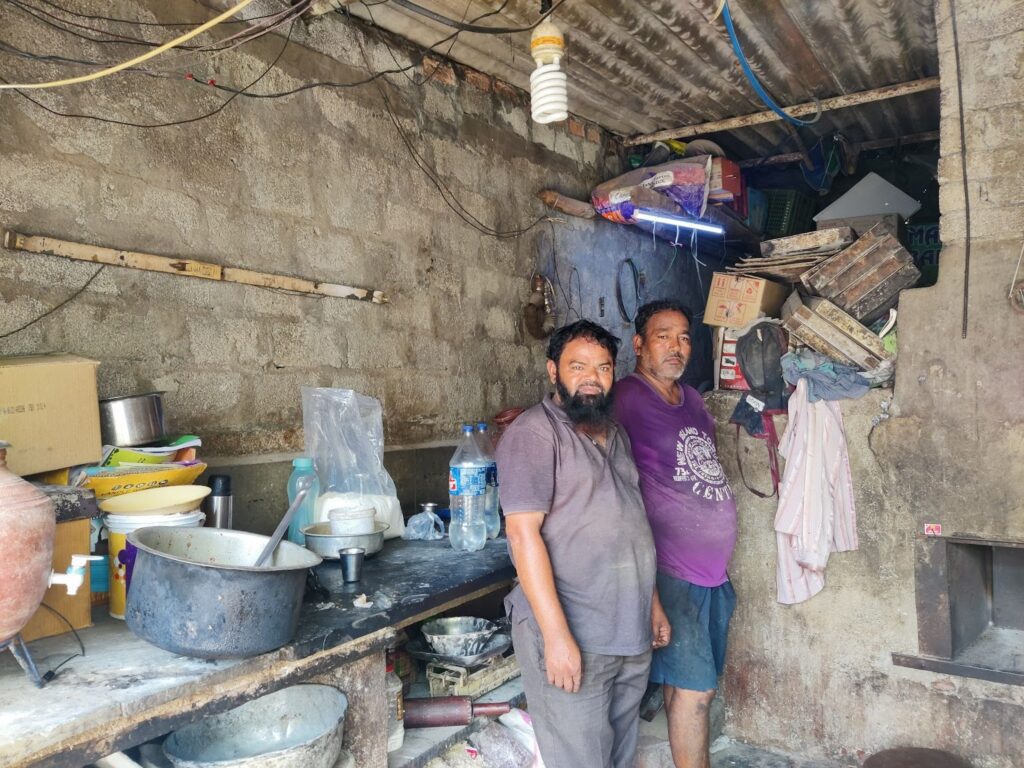
The picture of the duo, who have been running the bakery together, since the past seventeen years.
They start working at the break of dawn. Their routine includes tasks such as kneading the dough, rolling it, making the fillings and curries for the puffs, boiling the eggs, removing the eggshells etc. In this daily grind, being exposed to intense heat has become ingrained in the fabric of this profession. With the onset of Ramadan or ‘Ramzaan’ Season, the city was already under the grasp of the scorching summers. This sacred month, revered by Muslims worldwide, coincides with elevated temperatures that intensify the challenges of fasting. We delved into their fasting experience amid the rising heat, and one of the workers shared his struggle. He expressed how attempting to manage fasting and a back-breaking work like this proved taxing on his body forcing him to discontinue.
One of them described how they begin to feel the heat from the moment they light the fire in the oven – ‘Itni garmi hoti ki uthke bhaagne ko dil karta bahaar’. This means that the insides of the bakery get so hot, that they feel like running away outside. Halfway into the baking, their clothes are completely drenched in sweat. This was also evident during the interview, where we could see sweat dripping down their forehead to eyebrows and soaking in their shirt. They pointed towards the fan hanging from the ceiling saying – ‘yehi humara AC (air conditioner) hain’.
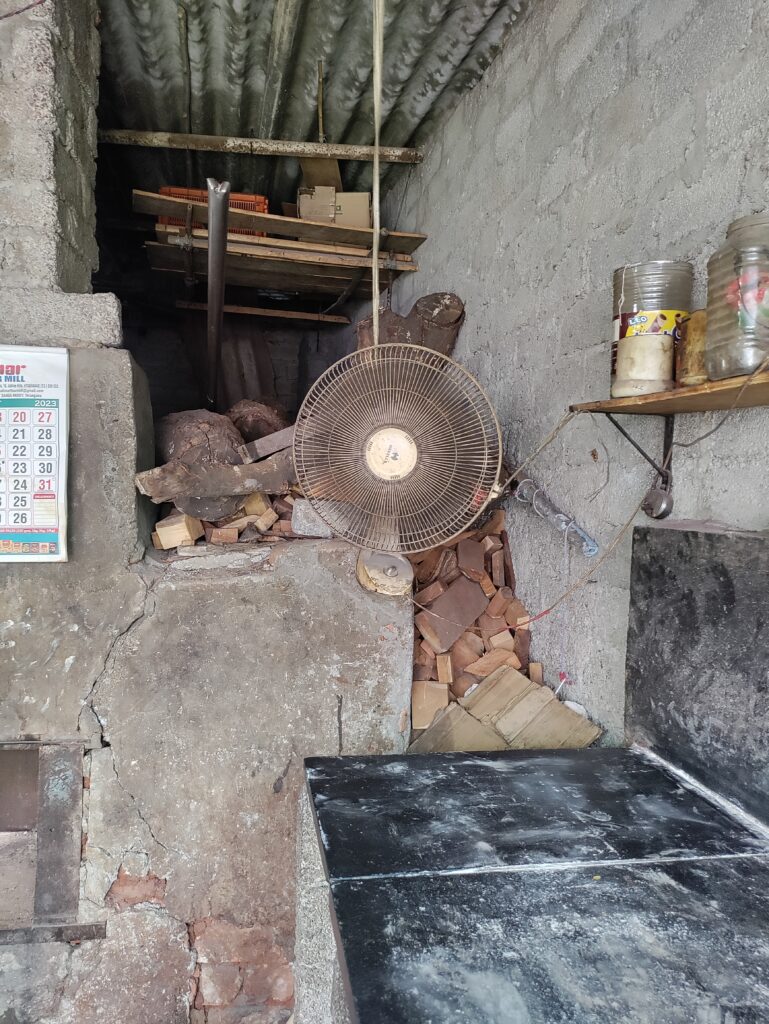
They mentioned how the fan served more than one purpose. It not only helped them stay cool and provide moments of relief from the burning experience of heat, but also helped in cooling the baked puffs that are freshly taken out from the oven. They mentioned that they constantly felt thirsty between work.
A Chamber of Artisanal Secrets
On further investigation to understand the operations inside the bakery, we were fascinated by their description of the wooden oven and how it was carefully curated with materials that helped retain, induce and generate heat. The oven, placed at the center largely influenced the temperature of the entire room. They mentioned that the internal chamber of the wood oven built within an external iron frame, rests on a hollow cuboidal structure which is composed of a combination of materials that retains heat effectively. They include 6 quintals each of glass shards, salt, slag pieces produced by smelting iron (they referred to it as chittiyum), pebbles found around the ocean (referred to as ‘Garr ka pathar’) and mica pieces (abhrak). The oven is a semi-circle structure, spanning over approximately 1-1.5 meters in depth, 60-90 centimeters in diameter and 30-40 centimeters is a testament of impeccable thermal engineering. The chamber is made by a craftsman (whom they referred to as ‘Ustaad’) who specialises in making such traditional wooden ovens. The materials for making the oven were mindfully chosen that not only induce but also retain heat efficiently.
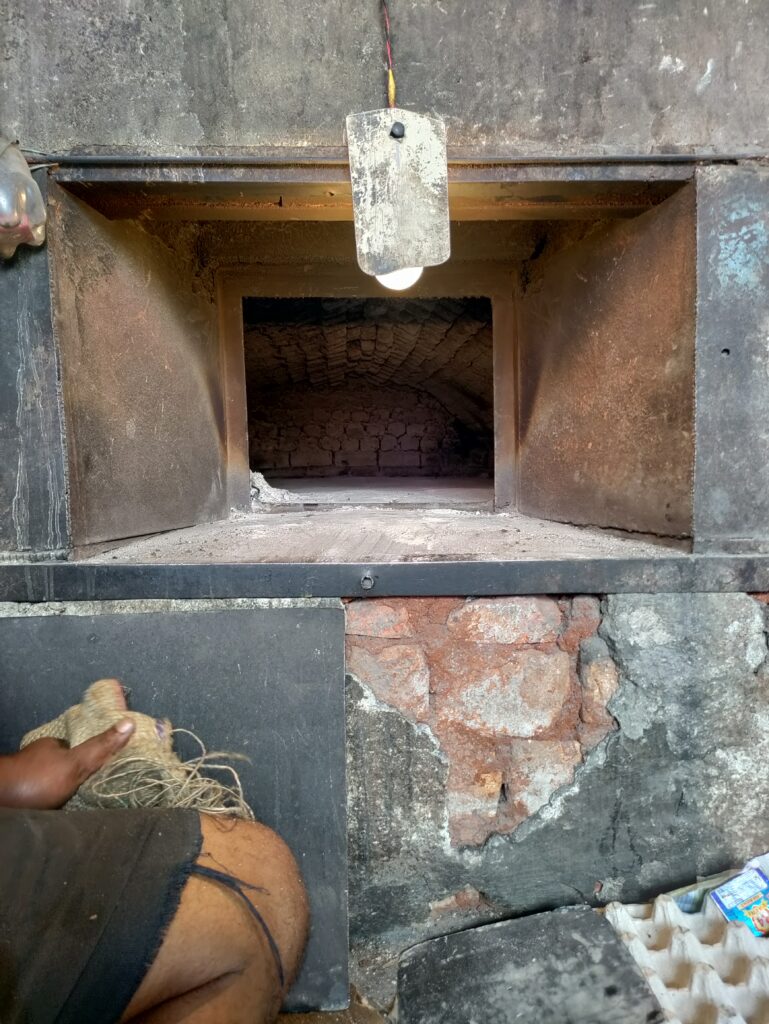
This image captures the external and the internal view of the wooden oven.
Understanding Epistemology in Baking
A deeper conversation with the duo helped us realise that running a bakery takes more than what meets the eye. They shared that baking in such an oven requires expertise, skills and knowledge (tacit) that they have honed over years of being in the business. They took immense pride in their craft while emphasising the importance of precision and estimation in the baking process. One of them shared – ‘Andaaza pe heating rakhna padta, warna jal jata pura’, which means that they have to estimate the amount of heat required in baking the puffs, or else the produce could get burnt. While explaining the nitty-gritties, they shared that the choice of fuel can largely alter the taste of the puffs. In a wood fired oven, they refrain from using kerosene or any other oils that help ignite the fire easily. Instead, they choose labor-intensive methods like igniting wood using paper, egg trays, small plastic packets, and pieces of cardboard. Determining the amount of wood that needs to go inside the chamber to generate just the ideal cooking temperatures to bake the puff, without being burnt is a skill they believe cannot be replicated by workers in a diesel oven bakery or a ‘diesel bhatti’. Moreover, knowing when and for how long to keep the chamber doors open and shut is another piece of knowledge they have acquired with practice and experience.
Transition Choices and Challenges
Looking across all kinds of bakeries that exist in Singareni, we kept circling back to one prime question – why hasn’t this bakery, which has been here for the past seventeen years, not transition to a modern baking oven? Wouldn’t that be much hassle-free? Would that not save their time and energy? Were the newer diesel bakeries the ones that had already made a transition? To find an answer to these, we turned to the duo.
They shared that they currently operate on a small scale. They produce approximately 400-450 puffs daily, adjusting their production depending on the received orders. The caterers in the neighbouring bus depots are their sole buyers. They added that there has been a significant decline in the business, post the lockdown and during the pandemic. Before the lockdown, their distribution also extended to the canteens of 6-7 theaters. He acknowledged that the pandemic has hit both the small and big businesses; however, it has mostly been the small bakeries that have continued to face the brunt of the struggle for survival. They believe larger bakeries, particularly those equipped with diesel ovens, as having a more dominant market presence, securing the majority of orders due to their higher production capacities.

The image shows the bakers packing the baked puffs in the cartons, ready to be delivered.
Until now, they had not considered transitioning to a different type of oven as according to them, their current setup worked seamlessly, aligning with their consistent demand and supply. However, due to a change in circumstances, specifically the landowner’s decision to build a home in their current location, the bakery is being displaced. Sharing a story from 25 years back, they expressed how they succumbed to the same fate of a similar wooden oven bakery that was demolished to make way for new constructions. They are now transitioning to a gas oven bakery, deeming it a suitable alternative in terms of rental costs, budget considerations, and logistical arrangements. They mentioned that this shift would only require an investment in the gas oven. which would be worth 35,000 rupees. This transition would definitely save considerable time and effort.
While expressing their desire to transition to a diesel oven bakery, they are mindful of an increase in their operation costs that would be unaffordable. Currently, there are two bakeries that operate on diesel ovens in Singareni Colony. They believe that baking is relatively easy and straightforward in such ovens as they are largely automated. In a diesel bhatti, one only has to set the oven to a particular temperature, the trays are automatically rotated inside, ensuring uniform exposure to heat for the even baking of the doughs, puffs or cakes. These bakeries are much bigger in their physical size and operational scale as compared to the traditional bhattis. They operate at a larger scale and their investments to returns ratio suffice.
However, according to Younus, ‘Maintaining a diesel oven requires significant effort. The initial investment in the business is a lot. The purchase price of the diesel oven alone is around 5 lakhs.
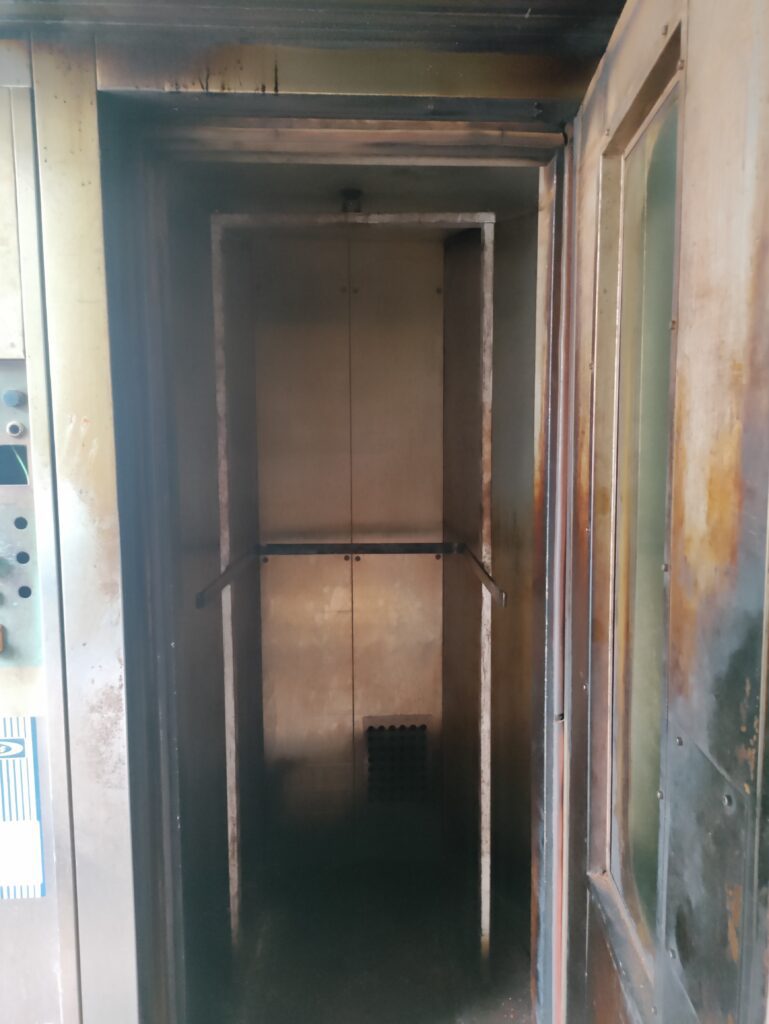
Additionally a diesel oven bakery would require a larger space to accommodate with rent amounting to approximately 12,000, compared to our current rental cost of 3000. Their orders total around 10,000, while mine only amount to 2250.’ Hence, switching to the diesel bakery would entail bigger space but increased rents; automated and time-efficient service but also accounting for diesel costs; additional workers and their salaries causing an overall increase in expense. (insert picture of a diesel oven)
Conclusion
In a world of fast changing technology, uncertainties form an integral part of professions like these. The bakery’s transition from a wooden oven to a gas oven left us with a plethora of questions: Would they still have to put in the same amount of labour post the transition? Does their clientele change? Will their placement in a commercial space help their business? How would their bodies react to the new working conditions etc.
As we circle back to the question of heat and its challenges, we are reminded time and again of their unwavering focus on providing for their families despite the heat, and how they have ‘learned to live with it’. This study serves as a reminder of the inherent uncertainty that shadows their daily lives – in terms of potential displacement, fluctuating daily orders, and unpredictable market conditions. People in Singareni continue living in the state of perpetual ambiguity where hope and anxiety co-exists. While facing eviction from their current location, they not only lose their ‘lakdi-ki-bhatti’ but also the sense of belonging and identity they’ve created over the years in this community.
- (Names have been changed) ↩︎
